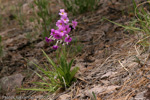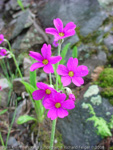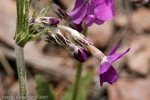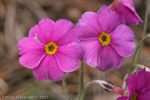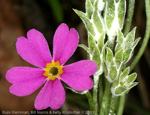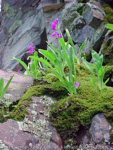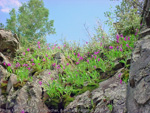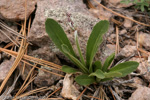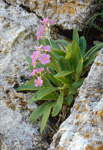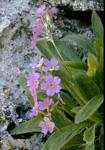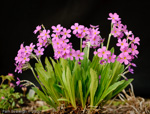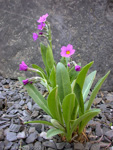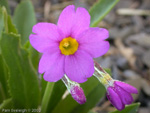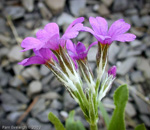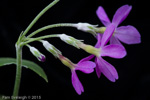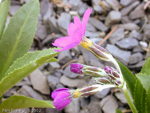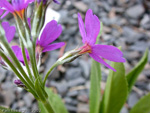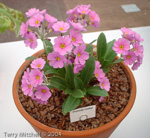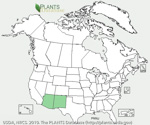Primula rusbyi Greene, Bull. Torrey Bot. Club 8(11): 122. 1881.
Section Parryi
Link to Flora of North America description
Type specimen: Rusby "Summits of Mogollan Mountains, New Mexico August 1881" (numbers 408, 252) resides at Harvard (specimen 00032281) and Philadelphia Herbarium (specimen 22109) and Smithsonian (specimens 00116511, 00116512) and New York Botanical Garden (specimens 214748, 329521, 329522, 329523).
P. ellisiae (syn): Pollard & Cockerell, Proc. Biol. Soc. Washington 15: 178. 1902. Type specimen: Ellis 404914 resides at Smithsonian (specimen 00116471).
P. rusbyi var. ellisiae (syn): L. O. Williams, Amer. Midl. Naturalist 17: 744. 1936. Type specimen: (7 syntypes listed) resides at M, P, F, K, Ry.
P. serra(syn): Small, Bull. Torrey Bot. Club 25: 319. 1898. Type specimen: Pringle s.n. Santa Rita Mtns Arizona 25 July 1884 resides at New York Botanical Garden (specimens 329524, holotype 329525) and Harvard (specimen 00274943) and University of Vermont (specimen UVMVT024979) and Field Museum Chicago (specimens V0097612F, V0097618F) and Paris (specimens P04544707, P04553611) and Philadelphia Herbarium (specimen 22110) and Smithsonian (specimen 00169541) and University of Notre Dame (specimen NDG38101) and Missouri Botanical Garden (specimen MO-022310 Determined as isotype but date incorrect).
Epithet: Named for the collector, Mr. H. H. Rusby.
Distribution: Arizona, New Mexico, Mexico.
See Primula World blog post.
A deciduous, North American species that grows in the mountains of Arizona, New Mexico and into Mexico. In this dry climate, it is able to survive in seepages and moist cliff edges. Distinguished by the lines of farina on the calyx, giving a striped appearance. Leaves lanceolate to spathulate, efarinose, indistinctly petiolate and with a evenly dentate margin. Flowers 4-12 per scape, heterostylous, rose-magenta with a yellow eye ringed in darker crimson.
P. ellisiae was described from individual plants from the Sandia Mountains, New Mexico based on longer calyx lobes in relation to the tube and a larger sized seed capsule. These characteristics vary within populations and according to the Flora of North America “preliminary genetic analyses (S. Kelso and P. Beardsley, unpubl.) reveal no substantive genetic distinction between these individuals and those from elsewhere in the range”. The name “Primula ellisiae” persists in cultivation but should be corrected to Primula rusbyi. If you have images of this species from Mexico (or Guatemala), please contact the webmaster.
